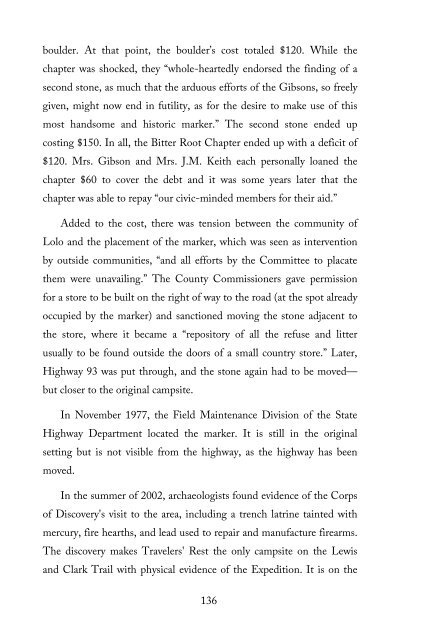Montana's DAR Markers . . . Honoring Where History Was Made
This book is a 200-page thank you to the women of Montana State Society Daughters of the American Revolution for their work in placing historical markers across the state of Montana. Starting in 1908, Montana DAR has installed 70 historical markers across the state. Of those, 33 remain. This book records why the markers’ sites were selected, their history, and the backstory of each.
This book is a 200-page thank you to the women of Montana State Society Daughters of the American Revolution for their work in placing historical markers across the state of Montana. Starting in 1908, Montana DAR has installed 70 historical markers across the state. Of those, 33 remain. This book records why the markers’ sites were selected, their history, and the backstory of each.
Create successful ePaper yourself
Turn your PDF publications into a flip-book with our unique Google optimized e-Paper software.
oulder. At that point, the boulder’s cost totaled $120. While the<br />
chapter was shocked, they “whole-heartedly endorsed the finding of a<br />
second stone, as much that the arduous efforts of the Gibsons, so freely<br />
given, might now end in futility, as for the desire to make use of this<br />
most handsome and historic marker.” The second stone ended up<br />
costing $150. In all, the Bitter Root Chapter ended up with a deficit of<br />
$120. Mrs. Gibson and Mrs. J.M. Keith each personally loaned the<br />
chapter $60 to cover the debt and it was some years later that the<br />
chapter was able to repay “our civic-minded members for their aid.”<br />
Added to the cost, there was tension between the community of<br />
Lolo and the placement of the marker, which was seen as intervention<br />
by outside communities, “and all efforts by the Committee to placate<br />
them were unavailing.” The County Commissioners gave permission<br />
for a store to be built on the right of way to the road (at the spot already<br />
occupied by the marker) and sanctioned moving the stone adjacent to<br />
the store, where it became a “repository of all the refuse and litter<br />
usually to be found outside the doors of a small country store.” Later,<br />
Highway 93 was put through, and the stone again had to be moved—<br />
but closer to the original campsite.<br />
In November 1977, the Field Maintenance Division of the State<br />
Highway Department located the marker. It is still in the original<br />
setting but is not visible from the highway, as the highway has been<br />
moved.<br />
In the summer of 2002, archaeologists found evidence of the Corps<br />
of Discovery's visit to the area, including a trench latrine tainted with<br />
mercury, fire hearths, and lead used to repair and manufacture firearms.<br />
The discovery makes Travelers' Rest the only campsite on the Lewis<br />
and Clark Trail with physical evidence of the Expedition. It is on the<br />
136





